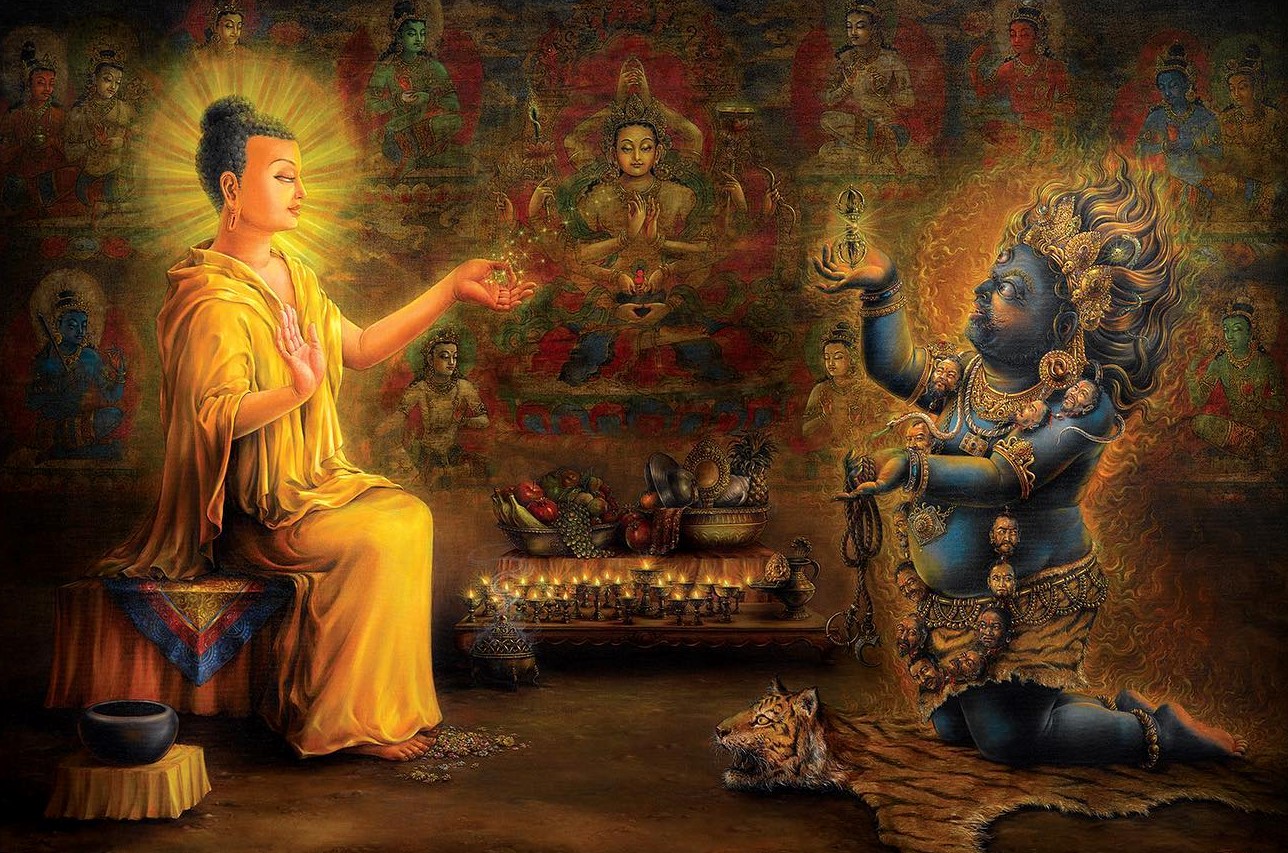Intangibility made tangible on canvas

By Aashish Mishra
Kathmandu, Feb. 8:
It is easy to tell stories. To gather a few people and explain to them that Gautam Buddha not only guided humans and animals to salvation but also preached sermons to gods from heaven is not a particularly difficult task.
Depending on our mastery of the language, we may be able to express the feeling that was contained in the Buddha’s words carried for miles by the currents of air, enlivening everything in its path. But how do you visualise this? How do you represent qualities like selflessness, compassion and impermanence? Tales and fables are innately abstract and incorporeal. How do you translate them to concrete and tangible paintings?
The answers to these questions can be found in artist Samundra Man Singh Shrestha’s paintings currently on display at the Museum of Nepali Art (MoNA), Kathmandu. Shrestha, through the use of colours, gestures, facial expressions and backgrounds, captures the feelings that our stories have been conveying through words for thousands of years.
To comprehend the boundless ethereal flows of divinity that are our deities and heave it out on canvas no larger than a house window is no mean feat. Yet, Shrestha has been consistently doing it for the better part of nearly 30 years as evidenced by his works presently on exhibition.
“It certainly takes a lot of effort and patience to achieve these kinds of results,” Shrestha said as he walked around the MoNA gallery. “You have to dive deep into the mythology, understand the context which surrounds these characters and be able to visualise the relationship between them to be able to give life to your art,” he said.
But it is not only Shrestha’s best pieces that visitors will see at the exhibition. Shrestha, 42, entered the art field at the age of 14 with sketches and drawings of comic book heroes, buildings and festivals he saw around him. As he was born and brought up in Basantapur area, he had been familiar with Nepali cultures and arts since his childhood.
His early works are on display too.
“Hopefully, this will show young artists that you do not achieve perfection overnight. You have to devote yourself to art, spend years honing your skills and above all, have patience.” “Yes! patience,” the ‘neo-traditional’ Paubha artist said. “It is one of the three important Ps of art with persistence and practice being the other two.”
Rajan Shakya, founder of MoNA, also hoped that Shrestha’s works would inspire young artists to develop their craft and aspire for the greatest of heights. But more than that, he hopes that exhibitions like these in spaces like MoNA call attention to Nepal’s silently vibrant art scene.
“Ours is a country of art. We just do not realise it,” Shakya said. “From the idol of Pashupatinath to the statues at Swayambhu to the pictures of gods and goddesses we have in our homes, our faith and culture revolve around art.”
Despite them being such an integral part of our Nepali-ness, neither the artworks nor the artists behind them have received much recognition from the people and the state. This is something Shakya wishes to change by hosting artists like Shrestha at MoNA.
Shrestha too feels the importance of platforms like the one created by Shakya cannot be understated. “Nepal is a nation of art, but they are scattered in shops and museums and collections. These [exhibitions] help showcase them in one place for people to see and acknowledge.”
As the title of the exhibition ‘The Journey of Artistic Mastery’ suggests, the works on display are meant to encourage and stimulate young minds and give people a sense of who Samundra is beyond the paintbrush. That is why none of the 50 paintings here is for sale. They are, however, exquisite examples of traditional Newa style of artistry residing as the core of conceptual contemporaneity; of binaries and juxtapositions of past and present, old and new, sacred and secular.
Shrestha’s solo exhibition will continue till February 19 from 10 am to 7 pm at MoNA, Thamel, Kathmandu.
Recent News

Do not make expressions casting dout on election: EC
14 Apr, 2022
CM Bhatta says may New Year 2079 BS inspire positive thinking
14 Apr, 2022
Three new cases, 44 recoveries in 24 hours
14 Apr, 2022
689 climbers of 84 teams so far acquire permits for climbing various peaks this spring season
14 Apr, 2022
How the rising cost of living crisis is impacting Nepal
14 Apr, 2022
US military confirms an interstellar meteor collided with Earth
14 Apr, 2022
Valneva Covid vaccine approved for use in UK
14 Apr, 2022
Chair Prachanda highlights need of unity among Maoist, Communist forces
14 Apr, 2022
Ranbir Kapoor and Alia Bhatt: Bollywood toasts star couple on wedding
14 Apr, 2022
President Bhandari confers decorations (Photo Feature)
14 Apr, 2022









